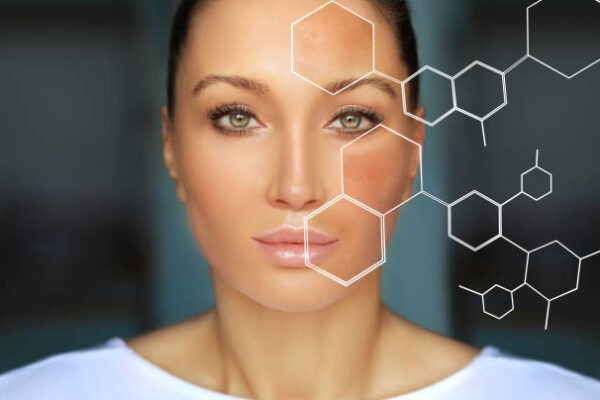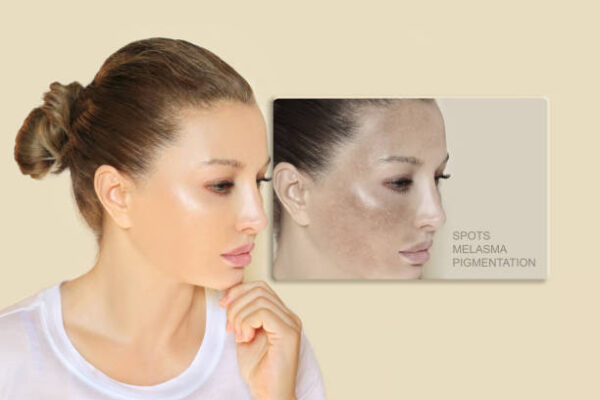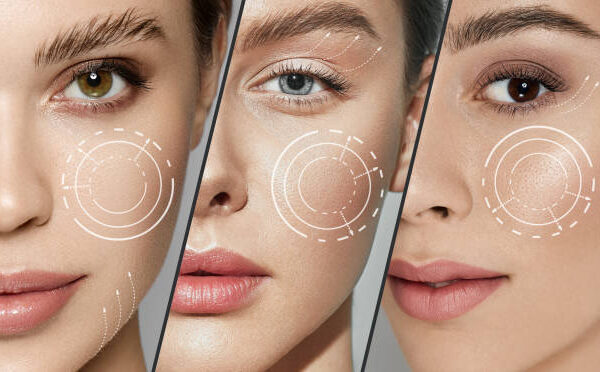Dark spots on the face are among the most common skin concerns people search for solutions to—whether they appear as age spots, sun damage, melasma, or post-inflammatory hyperpigmentation from acne. While these spots are harmless, they can make skin tone look uneven and leave you feeling less confident about your complexion. Best Dark Spot Corrector 2025
The beauty industry has no shortage of serums, creams, and spot correctors promising quick results. Some formulas, like vitamin C serum, retinol, or niacinamide, are well-studied and can help fade discoloration over time. Others combine multiple brightening ingredients to target pigment production and speed up cell turnover. But here’s the truth: not every product works equally for every type of dark spot, and expectations matter.
That’s why dermatologists often recommend a layered approach. At-home correctors are an excellent first step, but deeper or stubborn pigmentation—especially melasma—sometimes requires professional solutions like laser therapy, chemical peels, or light treatments. These dermatologist-guided procedures penetrate more effectively than creams alone and can deliver faster results, though they also come with higher costs and the need for expert supervision.
You’ll discover the best dark spot correctors of 2025—tested and recommended for different skin types and budgets. We’ll also cover the science behind ingredients that actually work, how to use them safely, and when it’s time to consider professional options like peels, lasers, and light-based therapies. By the end, you’ll know exactly which path to take for a clearer, more even complexion.
Our Top Picks
If you’re short on time and just want to know what works, here are the top dark spot correctors tested and trusted in 2025. Each option is tailored to specific needs—from stubborn melasma to everyday sun spots—so you can quickly find what’s right for you.
Best Overall: SkinCeuticals Discoloration Defense — dermatologist favorite for all-around hyperpigmentation, powered by tranexamic acid and niacinamide.
Best Budget Pick: Neutrogena Rapid Tone Repair Dark Spot Corrector — a drugstore-friendly retinol and vitamin C serum combo. Best Dark Spot Corrector 2025
Best for Acne Scars: Murad Rapid Dark Spot Correcting Serum — fades post-inflammatory hyperpigmentation effectively.
Best for Melasma: La Roche-Posay Mela B3 Serum — gentle yet effective, designed for hormonal pigmentation.
Best for Sensitive Skin: Eucerin Anti-Pigment Serum — formulated with thiamidol, safe for daily use.
How Dark Spots Form: Causes and Types
Dark spots, or areas of hyperpigmentation, develop when the skin produces excess melanin, the pigment that gives skin its color. This process can be triggered by many factors, and understanding the root cause helps you choose the right treatment.
Sun exposure is the most common culprit. Years of UV damage create “sun spots” or “age spots” that usually appear on the face, chest, and hands. Even with daily sunscreen, a history of tanning or unprotected exposure can leave lasting discoloration.
Hormonal changes, especially during pregnancy or while taking birth control, can lead to melasma—a stubborn form of hyperpigmentation that appears as patchy brown or gray areas, often on the cheeks and forehead.
Post-inflammatory hyperpigmentation (PIH) is another common type, especially for those prone to acne. After a pimple heals, excess pigment may remain, leaving a lingering mark even when the skin is clear.
Skin tone plays a role as well. Darker complexions naturally have more active melanocytes (pigment cells), which means they’re more vulnerable to stubborn hyperpigmentation—but also more prone to irritation if strong treatments are used without care.
In mild cases, topical serums with vitamin C, retinol, niacinamide, or azelaic acid can help fade discoloration gradually. But when spots are deep or resistant, dermatologists often recommend more advanced solutions like laser therapy, chemical peels, or light treatments. These procedures target pigment beneath the surface, where creams can’t always reach, and can significantly improve skin tone when used safely under professional guidance.
Recognizing which type of dark spots you have—whether sun-induced, hormonal, or post-acne—is the first step in deciding whether an at-home dark spot corrector will be enough, or if professional treatments should be considered.
Proven Ingredients That Fade Dark Spots
When it comes to fading dark spots, not all skincare ingredients are created equal. Some work on the surface to exfoliate dead skin cells, while others penetrate deeper to regulate pigment production. Here are the most effective ingredients dermatologists recommend:
Vitamin C
One of the most popular brightening ingredients, vitamin C is a powerful antioxidant that neutralizes free radicals from sun exposure and pollution. It helps fade existing dark spots while preventing new ones by blocking an enzyme involved in melanin production. A well-formulated vitamin C serum can also give skin a healthy, radiant glow.
Retinol (Vitamin A derivative)
Retinol is a gold-standard ingredient for overall skin renewal. It speeds up cell turnover, which helps fade hyperpigmentation, acne scars, and uneven texture. Over time, retinol also boosts collagen, making it an anti-aging powerhouse. Beginners should start slow, as it can cause dryness or irritation before the skin adjusts.
Niacinamide
This gentle but effective form of vitamin B3 works by reducing the transfer of pigment to skin cells. Niacinamide is well tolerated by sensitive skin, making it a great option for people who can’t handle harsher treatments. It also strengthens the skin barrier and calms redness.
Hydroquinone and Alternatives
Hydroquinone has long been considered the gold standard for stubborn pigmentation, especially melasma. However, because of potential side effects, many people now turn to alternatives like tranexamic acid, azelaic acid, and kojic acid. These ingredients regulate melanin in a safer, more gradual way while still delivering visible results.
Exfoliating Acids
Chemical exfoliants such as glycolic acid, lactic acid, and mandelic acid gently dissolve dead skin cells, revealing a more even complexion. They also prep the skin to absorb brightening serums more effectively. For sensitive skin, polyhydroxy acids (PHAs) offer a milder option.
Tranexamic Acid
Once only available by prescription, tranexamic acid is now featured in several over-the-counter serums. It’s especially effective for melasma and post-inflammatory hyperpigmentation, making it a go-to ingredient for people with persistent or hormone-related discoloration.
Natural Brighteners
Licorice root extract, mulberry, and green tea are gentle plant-based options for those looking for natural skin care. While results may be slower, they can complement stronger actives and reduce irritation when used in combination. Best Dark Spot Corrector 2025
Pro tip: The most effective dark spot correctors often combine several of these ingredients. For example, a formula with vitamin C, niacinamide, and glycolic acid can address pigmentation at multiple levels while keeping the skin balanced.
When choosing a product, think about your skin type. Stronger actives like retinol or glycolic acid are better for resilient skin, while sensitive skin types should stick with niacinamide, azelaic acid, or mild exfoliants.
Professional Treatments for Stubborn Dark Spots
Sometimes dark spots sit so deep in the skin that serums and creams alone can’t fully erase them. That’s where professional treatments come in. If you’ve tried over-the-counter products for months with minimal improvement, a dermatologist may recommend targeted procedures like laser therapy, chemical peels, or light treatments to break up pigment at its source.
Laser Therapy for Dark Spots
Laser therapy is one of the most effective options for stubborn hyperpigmentation, age spots, and acne scars. Using concentrated beams of light, dermatologists target melanin clusters beneath the skin’s surface. The pigment absorbs the energy, breaking down into smaller particles that the body gradually eliminates.
Different types of lasers exist:
Fractional lasers stimulate collagen and improve overall skin texture.
Q-switched lasers precisely target dark patches without damaging surrounding skin.
Laser therapy often requires multiple sessions, but results can be long-lasting. However, it’s essential to seek a skilled provider, especially for darker skin tones, since lasers carry a risk of worsening pigmentation if used incorrectly.
Chemical Peels for Pigmentation
Chemical peels involve applying a solution (such as glycolic acid, salicylic acid, or trichloroacetic acid) to exfoliate damaged layers of skin. By removing the top layer, chemical peels reveal fresher, more evenly toned skin underneath.
Superficial peels are gentle and good for mild discoloration.
Medium-depth peels penetrate further and can treat acne scars and melasma.
Deep peels deliver dramatic results but require longer recovery.
Chemical peels also enhance the effectiveness of at-home treatments since fresh skin absorbs serums better. With proper aftercare, including daily sunscreen, results can be visible in just a few sessions.
Light Treatments (IPL and LED Therapy)
Intense Pulsed Light (IPL) is a type of light treatment that works similarly to lasers but uses broad-spectrum light. It’s especially effective for sun spots, age spots, and redness from broken capillaries. Unlike lasers, which focus on a single wavelength, IPL delivers multiple wavelengths, making it versatile for treating uneven skin tone.
LED light treatments, on the other hand, are gentler and often used to reduce inflammation and support healing after more intensive procedures.
Are These Treatments Right for You?
While laser therapy, chemical peels, and light treatments deliver faster results than topical products, they also come with downtime, cost, and the need for professional supervision. Not all skin types respond the same way—people with sensitive skin or darker complexions should proceed with extra caution and always consult a board-certified dermatologist. Best Dark Spot Corrector 2025
How to Choose the Best Dark Spot Corrector for Your Skin
With so many serums and treatments on the market, choosing the best dark spot corrector can feel overwhelming. The right option depends on your skin type, the cause of your discoloration, and how aggressive you want your treatment to be. Here’s how to narrow it down:
1. Match Ingredients to Your Skin Type
Oily or acne-prone skin: Look for lightweight, oil-free formulas with niacinamide, salicylic acid, or retinol. These ingredients help fade post-acne marks while preventing new breakouts.
Dry skin: Hydrating serums with hyaluronic acid, vitamin C, and glycolic acid brighten while maintaining moisture balance. Creamier textures often work best.
Sensitive skin: Harsh actives can trigger irritation, so stick with niacinamide, azelaic acid, or gentle exfoliants. Avoid high-strength retinol or aggressive chemical peels without professional guidance.
2. Consider the Type of Hyperpigmentation
Sun spots / Age spots: Vitamin C serums, glycolic acid, and over-the-counter correctors are usually effective.
Melasma: This condition is often stubborn and hormone-driven. Tranexamic acid, kojic acid, and dermatologist-prescribed treatments are more effective. Professional options like laser therapy and chemical peels may also be considered.
Post-inflammatory hyperpigmentation (acne scars): Retinol, azelaic acid, and light treatments work well here, especially when combined with consistent sunscreen use.
3. Factor in Sensitivity and Tolerance
Start slow. Even dermatologist-recommended ingredients like retinol and vitamin C can cause redness or peeling if introduced too quickly. Patch-test new products and use them every other night until your skin builds tolerance.
4. Prioritize Sun Protection
No matter which corrector you choose, daily sunscreen is non-negotiable. Without it, UV rays will undo your progress and cause new dark spots to form. Dermatologists often say sunscreen is the “best dark spot corrector” because it prevents worsening pigmentation in the first place.
5. Balance Cost and Commitment
High-end products often combine multiple brightening actives in stable formulas, but affordable options can still be effective if used consistently. The key is patience—most treatments take 6–12 weeks to show noticeable results.
Tips to Maximize Results and Prevent New Spots
Fading dark spots takes time, but the right habits can speed up results and prevent new ones from forming. Think of it as a two-part process: correcting what’s already there while protecting your skin from future damage.
1. Commit to Daily Sunscreen
Sunscreen is the single most effective tool against hyperpigmentation. Even the best dark spot corrector won’t work if UV rays keep triggering melanin production. Apply a broad-spectrum SPF 30 or higher every morning, even on cloudy days or when staying indoors near windows. Reapply every two hours if you’re outdoors.
2. Layer Products Wisely
For maximum effectiveness, apply products in the right order. After cleansing, use a vitamin C serum in the morning and retinol at night. Follow with a moisturizer and sunscreen. Niacinamide can be layered in both routines to calm and protect the skin barrier. This combination supports faster fading while minimizing irritation.
3. Exfoliate Regularly
Gentle exfoliation with glycolic acid, lactic acid, or enzyme-based scrubs helps remove dead skin cells, allowing brightening ingredients to penetrate better. Stick to 1–3 times a week, depending on your skin’s tolerance. Over-exfoliation can cause redness and even trigger more dark spots, so moderation is key.
4. Support Your Skin from Within
Lifestyle choices also play a role in skin clarity. Antioxidant-rich foods, adequate hydration, and quality sleep all support skin repair. Some people even add supplements like collagen or glutathione to their routine, though results vary.
5. Avoid Picking or Scratching
Post-inflammatory hyperpigmentation often lingers after acne or skin injuries. Picking at pimples or scratching at scabs worsens pigmentation and slows healing. Instead, treat breakouts with targeted products and let skin heal naturally.
6. Stay Consistent
Dark spot correction isn’t a quick fix. It usually takes 8–12 weeks of regular use before noticeable fading occurs. Patience and consistency are your best allies.
Conclusion: Finding the Right Path to Clearer Skin
Dark spots may be stubborn, but they’re not permanent. With today’s options—ranging from dermatologist-approved ingredients like vitamin C, retinol, and niacinamide to professional solutions such as laser therapy, chemical peels, and light treatments—there’s an effective path for every skin type and budget.
The key is understanding the cause of your pigmentation. Sun spots, melasma, and acne scars all respond differently, which is why the “best dark spot corrector” isn’t the same for everyone. For some, a vitamin C serum paired with sunscreen may be enough. For others, stubborn hyperpigmentation requires advanced dermatology treatments. Best Dark Spot Corrector 2025
Consistency, patience, and prevention matter as much as the corrector you choose. Daily SPF, gentle exfoliation, and avoiding skin picking can prevent new discoloration from forming and protect the progress you’ve made.
If you’re unsure which route to take, start with a well-formulated serum and consult a dermatologist for personalized guidance. Whether you choose an at-home routine or professional treatments, you can achieve brighter, more even-toned skin over time.
Frequently Asked Questions
1. What is the best dark spot corrector?
The best dark spot corrector depends on your skin type and the cause of your pigmentation. Dermatologist-recommended options often combine vitamin C, retinol, and niacinamide. For melasma or stubborn pigmentation, formulas with tranexamic acid, kojic acid, or hydroquinone alternatives work best. If drugstore-friendly is your goal, Neutrogena and La Roche-Posay have effective, affordable serums.
2. How long does it take to see results?
Most over-the-counter dark spot correctors take 8–12 weeks of consistent use before noticeable fading occurs. Professional options like laser therapy, chemical peels, or light treatments may deliver faster improvements, but they usually require multiple sessions and careful aftercare. Patience is key—hyperpigmentation develops over time and fades gradually. Best Dark Spot Corrector 2025
3. Are professional treatments better than at-home products?
Yes and no. Professional options like laser therapy, chemical peels, and light treatments can deliver dramatic results for stubborn hyperpigmentation, melasma, or acne scars. However, they’re more expensive, carry risks (like irritation or rebound pigmentation), and require downtime. At-home dark spot correctors are safer for everyday use and work well for mild to moderate discoloration. Many people combine both approaches for best results.
4. Is laser therapy safe for all skin tones?
Not always. While laser therapy can be highly effective, darker skin tones are at higher risk of developing post-inflammatory hyperpigmentation if the wrong type of laser is used. That’s why it’s critical to see a board-certified dermatologist who has experience treating diverse skin tones. Alternatives like chemical peels or tranexamic acid serums may be safer for some.
5. Do chemical peels really work for dark spots?
Yes. Chemical peels exfoliate the skin at different depths, which helps fade pigmentation and reveal brighter, smoother skin. Superficial peels are ideal for mild sun spots or uneven tone, while medium-depth peels target acne scars and melasma. Deep peels deliver dramatic results but require significant downtime and should only be done under expert care. Best Dark Spot Corrector 2025




